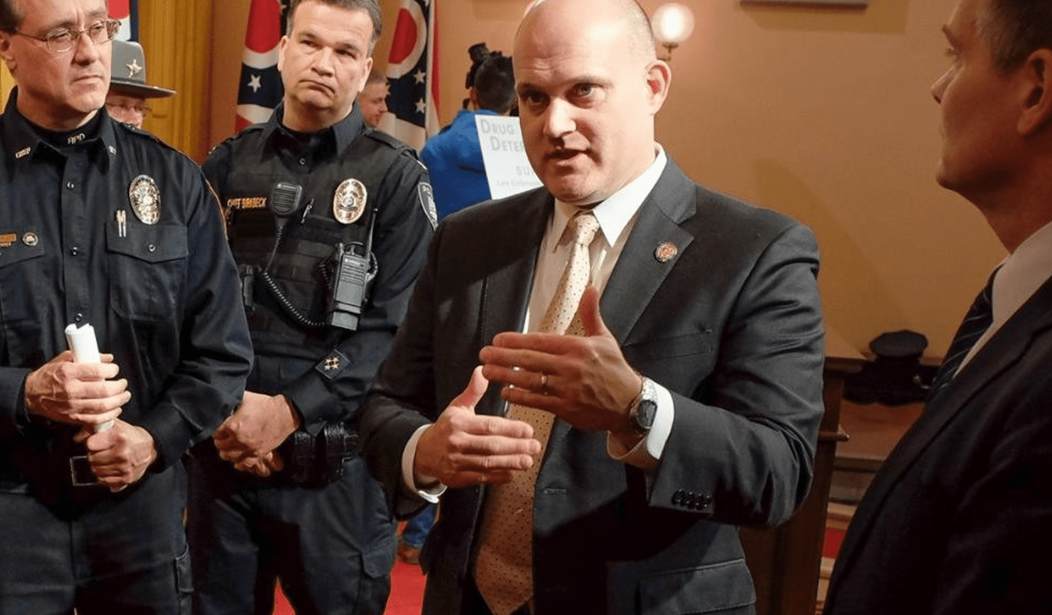A member of the Ohio General Assembly plans to introduce a bill that will allow the state to use fentanyl seized in drug busts to execute criminals who are sentenced to the death penalty, hoping to alleviate the shortage of execution drugs. Scott Wiggam, a Republican from Wooster, sent an email to his colleagues on Monday asking them to cosponsor his bill, which could help to clear the backlog on Ohio’s death row.
“In the coming weeks, I plan to introduce legislation that will allow the State of Ohio — specifically the Ohio Department of Rehabilitation and Corrections — to utilize seized fentanyl as a drug to be administered in death penalty cases,” Wiggam wrote in the email. “Up until this point, the appropriate drugs for death penalty administration have not been readily available and I believe that seized fentanyl (considered forfeited contraband through the court system) is the best solution to this problem.”
Gov. Mike DeWine has delayed several executions this year, citing the inability to obtain the drugs necessary to perform lethal-injection executions after a judge ruled that the drug cocktail the state was using for executions would “almost certainly subject [a person] to severe pain and needless suffering.” At present, there are 22 inmates scheduled for execution in Ohio through 2022.
Compounding the problem, drugmakers are threatening to stop selling all drugs to the state if they continue to use some of them to execute convicted criminals. An Ohio law that shielded drug companies from knowing how the drugs were used, signed into law by Gov. Kasich in 2014, was recently allowed to sunset. DeWine has been discussing alternative means of executing criminals as blacklisting by drug manufacturers becomes a real possibility. Ohio law currently specifies that only legal injections may be used in executions.
As a result of the inability of the state to procure the needed drugs, Wiggam is proposing to instead use fentanyl — a synthetic opioid 50 times more powerful than morphine — which has been responsible for thousands of overdose deaths in Ohio. The bill will instruct the Department of Rehabilitation and Corrections to “work in conjunction with the Drug Enforcement Administration to obtain pre-existing seized fentanyl and the DRC will have set rules for appropriate handling, testing, and administration of the drug,” Wiggam’s email said.
Wiggam told PJM that he fears the death penalty could go away in Ohio if the problem is not addressed. “There seems to be every excuse under the sun to say that the death penalty cannot be done,” he said. “I’m concerned, basically, that there’s an effort to kill the death penalty by a thousand cuts without having the state of Ohio have a conversation about the morality or efficacy of the death penalty.” While he declined to name names, Wiggam aid he’s “had conversations with individuals that would be connected with the dialogue [about the death penalty] and there seems to be a thought that nothing seems to work, so we just can’t do it.”
The Ohio lawmaker said he’s open to revisiting the shielding law and to discussing the use of other drugs seized by law enforcement, but reasoned that there’s enough fentanyl being held by law enforcement in the state “to kill more than half of the state’s population.” Once the case is over, the drugs are scheduled for destruction, but Wiggam thinks that some of them could be used to perform executions.
According to the DEA, fentanyl produces “relaxation, euphoria, pain relief, sedation, confusion, drowsiness, dizziness, nausea, vomiting, urinary retention, pupillary constriction, and respiratory depression.” During an overdose, individuals experience “stupor, changes in pupillary size, cold and clammy skin, cyanosis, coma, and respiratory failure leading to death.”
Last August, Nebraska became the first state to carry out the death penalty using fentanyl. NPR described the execution of Carey Dean Moore:
Tuesday morning’s execution of Carey Dean Moore is also the first time the powerful synthetic opioid fentanyl had been used in a lethal injection in the U.S.
Moore, who has been in prison since 1980 after he was convicted in the murders of two taxi drivers, did not put up a legal challenge to the execution protocol. He had seven other execution dates before this one.
The first drug was administered at 10:24 a.m. local time, and Moore was pronounced dead at 10:47 a.m., according to the Nebraska Department of Correctional Services.
“Witnesses said that there appeared to be no complications in the execution process,” The Associated Press reported. “At one point while on the gurney, Moore turned his head and mouthed several words to his family, including ‘I love you.'”
Wiggam’s bill goes a step further by using fentanyl seized by law enforcement rather than relying on a drug manufacturer, as Nebraska’s law does.
Not everyone thinks using fentanyl seized in drug busts for executions is a good idea.










Join the conversation as a VIP Member